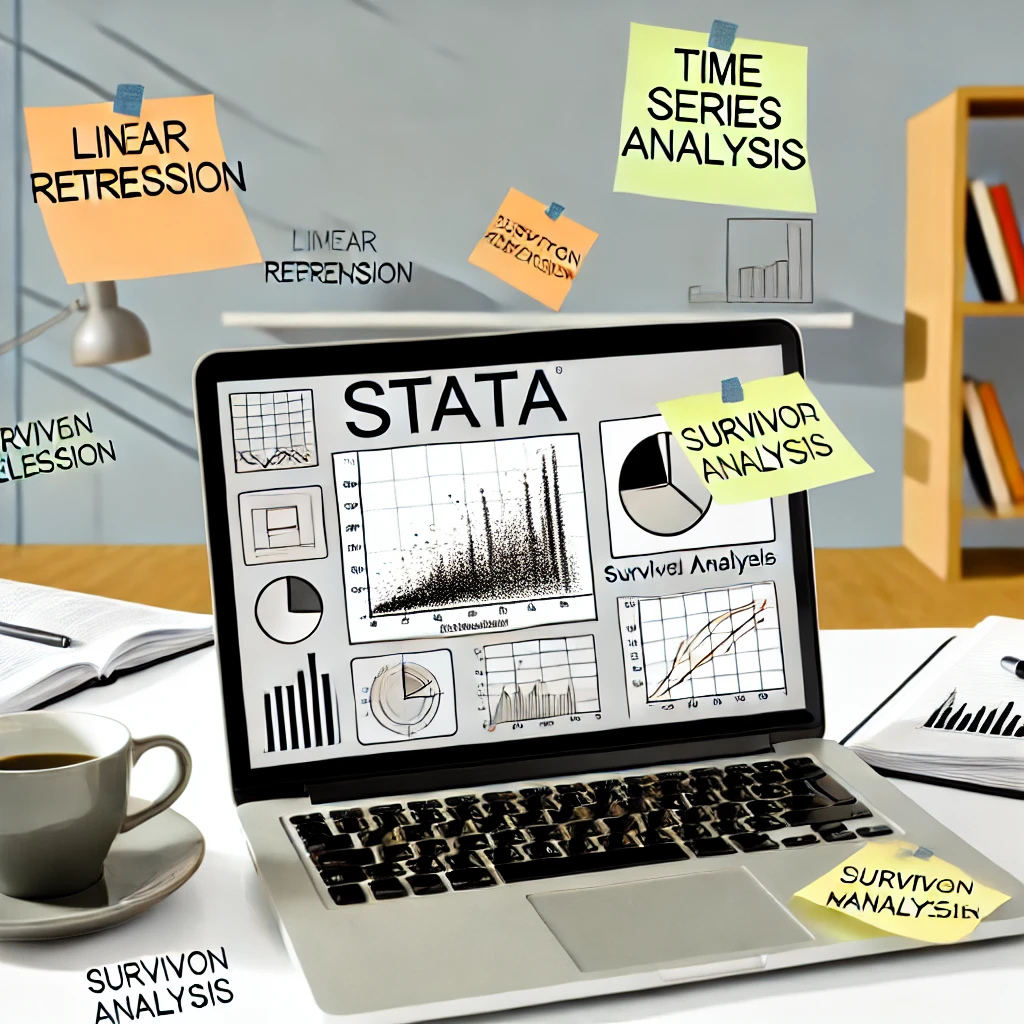
STATA: Tailored for PhD Scholars
Stata is a renowned statistical software package that has become a cornerstone for researchers across various academic fields. Its comprehensive suite of features makes it particularly valuable for PhD scholars who need to conduct complex data analyses and manage intricate datasets. Whether you’re engaged in econometrics, health research, or social sciences, Stata offers powerful tools to facilitate rigorous and reliable research. This blog explores how PhD scholars can harness Stata’s capabilities to enhance their research efforts, highlighting its key features and practical applications with illustrative examples.
Key Features of Stata
One of Stata’s most significant advantages is its extensive range of statistical methods. PhD scholars often face the challenge of analyzing complex data to uncover meaningful insights. Stata provides a robust array of analytical techniques, including linear regression, time series analysis, survival analysis, and multilevel modeling, each of which is crucial for addressing different types of research questions.
Linear Regression
Linear regression is a fundamental technique used to understand the relationship between dependent and independent variables. For instance, a PhD scholar studying the impact of a new teaching method on student performance might utilize Stata’s linear regression tools to explore how various factors, such as instructional methods and student demographics, affect academic outcomes. Stata’s linear regression features enable researchers to conduct a detailed examination of relationships, including the assessment of interaction effects and multicollinearity. This capability is essential for drawing accurate conclusions and making informed recommendations based on the data.
Time Series Analysis
Time series analysis is another powerful feature of Stata, crucial for examining data collected over time. Researchers analyzing economic indicators, such as GDP growth or unemployment rates, can leverage Stata’s time series tools to identify trends, seasonal patterns, and cyclical movements. This analysis provides valuable insights into long-term economic dynamics and helps in forecasting future developments. For example, a PhD scholar exploring the effects of economic policy changes might use Stata to analyze historical data and predict future economic trends, thereby informing policy decisions and contributing to the field of economic research.

Survival Analysis
Survival analysis is a technique used to study the time until an event occurs, such as patient survival times following a new treatment or time to failure in engineering systems. In health research, for instance, a PhD scholar examining clinical trial data can employ Stata’s survival analysis features to model survival probabilities, evaluate the impact of covariates, and generate survival curves. This method is crucial for understanding treatment efficacy, assessing patient outcomes, and making evidence-based recommendations for medical practices.
Multilevel Modeling
Multilevel modeling is another advanced feature offered by Stata, designed for analyzing data with hierarchical structures. This technique is particularly useful when studying phenomena that occur at multiple levels, such as students within schools or patients within hospitals. A PhD scholar investigating the impact of school-level interventions on student achievement might use Stata’s multilevel modeling tools to account for variations at both individual and school levels. This approach provides a more nuanced understanding of how interventions affect different layers of the hierarchy and helps in designing targeted interventions that address both individual and systemic factors.
Data Management
In addition to its statistical capabilities, Stata excels in data management, which is a critical aspect of effective research. Managing and preparing data accurately is essential for ensuring the validity and reliability of research findings. Stata offers a range of tools for data import, export, and cleaning, facilitating smooth data handling processes.
Data Import and Export
Stata supports importing data from various formats, such as Excel and CSV files, and exporting results in publication-ready formats. This flexibility streamlines the process of integrating data from different sources and preparing it for analysis. For instance, a PhD scholar working with large-scale survey data might use Stata to import responses from Excel, clean the dataset, and then export the results in a format suitable for inclusion in their dissertation or academic papers.
Data Cleaning
Data cleaning is a crucial step in ensuring the quality of research data. Stata provides tools for identifying and addressing missing values, outliers, and inconsistencies. For example, a researcher analyzing clinical trial data might use Stata to detect missing values in patient records and apply appropriate methods for handling them, such as imputation or exclusion. This ensures that the dataset used for analysis is accurate and reliable, thereby enhancing the credibility of the research findings.
Variable Management
Stata also allows researchers to create new variables, recode existing ones, and manipulate data to fit their analytical needs. A PhD scholar studying consumer behavior might use Stata to generate new variables that categorize respondents based on their purchasing frequency. This capability is essential for preparing datasets for complex analyses and ensuring that variables accurately represent the constructs of interest.
User-Friendly Interface
The user-friendly interface of Stata makes it accessible to researchers with varying levels of expertise. The software offers both a command-line interface and a point-and-click interface, catering to different user preferences. The command-line interface is designed for advanced users who need to execute complex commands and automate repetitive tasks. For example, a researcher analyzing a large dataset might write scripts in Stata’s command-line interface to automate the process of running multiple regression models or generating summary statistics.
Conversely, the point-and-click interface provides a more visual approach, making it easier for less experienced users to perform analyses without extensive programming knowledge. A PhD scholar new to statistical software might use the point-and-click features to conduct basic analyses, such as generating descriptive statistics or creating graphs, before moving on to more advanced techniques.

Reproducibility
Reproducibility is a fundamental principle in research, and Stata supports this through its do-file feature. Do-files are scripts that record all commands used during data analysis, providing a clear and replicable record of the analytical process. This documentation ensures transparency and allows other researchers to replicate the study and verify results. For instance, a PhD scholar preparing a dissertation might use do-files to meticulously document every step of their data analysis, from data cleaning to statistical modeling. This thorough documentation enhances the credibility of the research and facilitates reproducibility.
Versatility Across Research Fields
Stata’s versatility extends across various research fields, demonstrating its broad applicability. In econometrics, for example, Stata is widely used to analyze economic data and test theories. The software supports techniques such as panel data analysis and instrumental variable estimation, making it a valuable tool for economists and researchers in related fields. In health research, Stata is employed to analyze clinical trial data and model patient outcomes, contributing to advancements in medical research and practice. In the social sciences, Stata is used to explore social trends and test theoretical models, showcasing its adaptability to different research domains.
Conclusion
In conclusion, Stata provides PhD scholars with a powerful and versatile tool for conducting thorough data analysis and management. We at PhD Research Assistance, provide comprehensive statistical methods, efficient data handling features, and user-friendly interface making it an indispensable asset for academic research. By leveraging Stata’s capabilities, researchers can perform detailed analyses, manage complex datasets, and present their findings effectively, ultimately contributing to the advancement of knowledge in their respective fields.